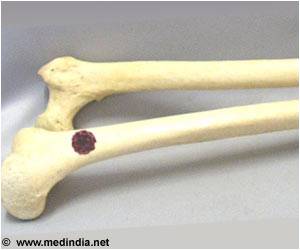
The goal with click chemistry is to maximize the delivery of therapeutic drugs specifically to the cancer tumor to increase effectiveness while minimizing the circulation of those drugs throughout the bloodstream and causing dangerous side effects.
For years, many chemists assumed that while click chemistry has been successful in mice, the strategy would not work in large dogs or people because the size of the body might be too big for the two sides of therapy-delivering molecules to find each other and snap, or ‘click,’ together. Bryan collaborated with Brian Zeglis, an associate professor at Hunter College in New York who specializes in click chemistry, to conduct the first-ever successful ‘proof-of-concept’ study at the MU College of Veterinary Medicine. Using click chemistry, doses of radiopharmaceuticals were delivered specifically to the tumors in five dogs that weighed more than 100 pounds and had bone cancer.
Advertisement
Bryan has been researching veterinary and comparative oncology for nearly two decades. He said some dogs with one known bone tumor have additional bone tumors hiding in their body’s skeleton. An additional benefit of studies involving imaging scans and click chemistry is the ability to discover if additional cancer tumors are located in a dog’s skeleton and impacting their health.
A Leader in Treating Cancer – for People and Pets
The MU College of Veterinary Medicine, which earned more than $14 million in federal research funding last year from the National Institutes of Health, is the site of clinical trials for cancer that attract people and their pets from California, Florida, New York and states across the country.
“It is heartwarming to be a part of it because the patients’ families realize it is not just about better outcomes for their specific dog, but they are also contributing to better outcomes for other dogs in the future and hopefully better health outcomes for people as we translate these advances from the dogs to the human side,” Bryan said.
While this was a successful ‘proof-of-concept’ imaging study involving click chemistry, Bryan’s long-term goal is to develop a therapy using radiopharmaceuticals, potentially involving an antibody-targeting molecule, to treat dogs with bone cancer that may not be well enough for other treatments that involve surgery.
READ RELATED: Public health purge at the CDC sees 3,000 staff who were hired during the Covid crisis laid off
“This research is also an example of precision medicine, a key part of MU’s NextGen Precision Health initiative, because we are using the molecules associated with the specific tumor to deliver the therapeutic dose of treatment,” Bryan said. “We collaborate with the MU Research Reactor, the Molecular Imaging and Theranostics Center, and Washington University in St. Louis, so it is a team effort.”
In 2020, Bryan collaborated with ELIAS Animal Health to create a precision medicine approach – a vaccine from a dog’s own tumor – to target and kill cancer cells in dogs suffering from osteosarcoma. The success of the treatment in dogs led the Food and Drug Administration to grant a rare fast-track designation for ELIAS Animal Health’s parent organization, TVAX Biomedical, to study the ELIAS immunotherapy approach to treat glioblastoma multiforme, a cancerous brain tumor in humans.
“The last dog that participated in that study just died a few weeks ago, five years out from their original diagnosis of bone cancer, and the dog never relapsed with its cancer, so the dog was able to live the rest of its life cancer-free due to the immunotherapy,” Bryan said. “Our overall goal is to come up with different tools in our toolbox to effectively help treat dogs with cancer, and one day even people, too.”
“Pretargeted PET of Osteodestructive Lesions in Dogs” was published in Molecular Pharmaceutics. Funding was provided by Hunter College.
Source: Eurekalert
Source:




